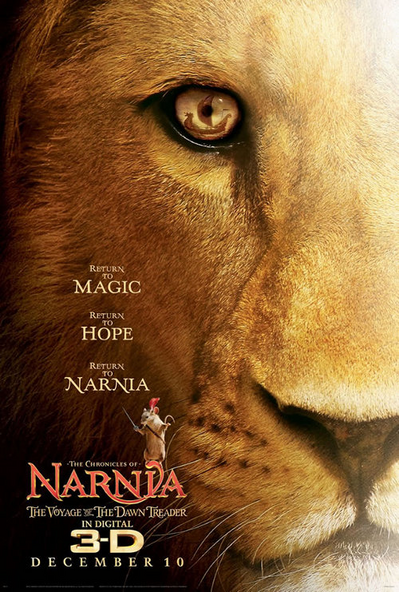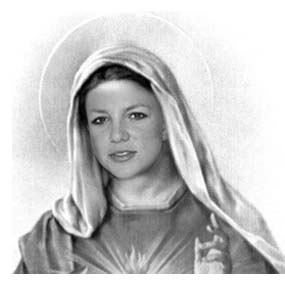But alas, these are the days when even so-called movie critics don’t bother to do anything but show up at the movies with poison pen in hand. So, to the several inane reviewers who thought that the Voyage of the Dawn Treader was borrowing from the spectacularly long and boring Pirates of the Caribbean; Voyage to the End of the World movie— shame on you. C.S Lewis’ novel about journeying through mysterious islands heading for the Dark Island and the source of all woe preceded even the thought of Johnny Depp playing Captain Jack Sparrow by more than a half a century! Go read C.S. Lewis’ books. If there was any borrowing it went in the other direction.
The Narnia franchise was in some significant danger after the botch job Disney did with the Prince Caspian movie, deleting much crucial and Christian dialogue and scenes from the novel. It was choppy and the CG was cheesy in various scenes. Thank heavens for Chip and Michael Flaherty and Walden Media for rescuing these wonderful children’s stories and continuing to put them on film. They actually care about doing justice to C.S Lewis’ original vision. When Chip came to Asbury last Friday night for Narnia Night 3 at the college, I had a chance to talk with him briefly after the introducing of the film to the community, and it is clear that this film must do well for their to be a fourth in the series. My advice to all Lewis lovers—- is get out and support this movie in droves. These are creative Christian stories worthy to be retold on the big screen. So how was this movie?
First of all I would say that the acting in this 1 hour and 52 minute is an improvement over the two previous episodes, on the whole. Perhaps this is because Ben Barnes as Caspian, and Georgie Henley as Lucy, and Skandar Keynes as Edmund have all grown up some, and their performances are those of more mature actors. And then there is the addition of Will Poulter as the memorable and annoying Eustace who nearly steals the show. He is splendid. But of course the real show stealer continues to be the much-beloved and gallant Reepicheep a true ‘mouseketeer’ musketeer. Even Eustace as the dragon doesn’t upstage Reepicheep.
Secondly, kudos to Walden for getting the CG and special effects right. They are much better in this film than in Prince Caspian though the price of seeing this film in Real 3D was steep— $11.50 even at the truly first showing on Dec. 10— (it began at 12:01 a.m.). Whether you see this in 3D or not, Michael Apted has done a wonderful job of filming in New Zealand and Australia. The boat is beautifully rendered, the sets and scenes are memorable, the costumes good, and various of the special characters unforgettable— have you talked to your local minotaur lately? How about the hilarious Dufflepuds— elf like creatures with one huge foot each? There are plenty of memorable fantasy characters in this film to keep children and adults smiling, and at points enthralled. The less compelling scenes in the movie are in fact places where Lewis’ original novel was not as good as it might be. Don’t blame the film makers. In a separate post I will talk about J.R.R. Tolkien’s take on Lewis’ children’s stories compared to his own epic sagas in Lord of the Rings.
Thirdly, the telling of sea tales is a perilous thing if you try to make it consistently interesting, especially when translating it to film. ‘Master and Commander’, the Russell Crowe film, was pretty good, but too many such films end up becalmed and dead in the water, which may explain why we haven’t had a good attempt yet at putting Herman Melville’s classic on the big screen. Only ‘Mutiny on the Bounty’ really escaped the trap of the more serious sea films.
Of course the origins of such tales go back to Homer’s Odyssey at least, and there are places in this Narnia movie and the book where Lewis’ indebtedness to that classic source is evident. But it is very easy indeed to make a long boring movie about a captive audience on a boat—- oh, think of that Pirates of the Caribbean movie again.
I am here to tell you, this is no such movie, despite certain jaundiced critics to the contrary. The Voyage of the Dawn Treader film has enough going on on the ship, and on the islands they visit to keep interest sustained throughout to the dramatic conclusion of the story. And no, the film is not too long, at just under two hours. The film must be able to stand on its own in terms of message and coherency without the audience knowing the novel, and it passes the test.
But if you haven’t read the Narnia tales, could you tell from the movie alone what Lewis was trying to teach children? In the Prince Caspian film the answer was no, due to deliberate and bad editing. In this film the answer is decidedly yes, and here are some of the major points that are emphasized.
If we want to know the real source of most evil in this world, we need look no further than the human heart. And if one wants to conquer the evil without, one ought to first start, indeed needs to start by conquering the evil within. The real source of the problems for our heroes on this voyage lies with the weaknesses and the sinful inclinations within each person, which when put under the pressure of some temptation is prone to sin, to selfishness, to spectacular self-destruction. In some cases, these longings and inclinations are not all bad in themselves— for instance, Lucy longs to be beautiful like her sister Susan and must learn the lesson that the only person each of us should long to be is ourselves— for each of us are unique, and fearfully and wonderfully made. Of course we should long to always be our best selves.
But then comes the second important lesson, namely that for a Eustace to be ‘un-dragoned’ it requires outside help. It requires Aslan. It isn’t really possible for a person to transform themselves from dragon to likable boy through only determination or some human self-help program. Only Aslan can really change Eustace, but Eustace must first realize he needs to change, and indeed must want to be changed.
This is certainly a children’s morality play, and in many ways it is a story about the importance of growing up. Towards the end of the movie we are reminded that the older Pevensies cannot return to Narnia again. They are too old. And alas, Lucy and Edmund are too old by the end of this movie.
Does this mean they must leave Aslan behind, a figment of a child’s creative imagination? No indeed, for as Aslan says— ‘You will know me by another name in your world’ and ‘We will meet again there, for I will always be with you’.
What Lewis is getting at is that fantasy, including children’s fantasy of a Christian sort, not merely helps a child cope with a raw real world, but in fact provides something of a guide to what is really important and what they should look for in their world. But they must look for it with the openness and wide-eyed wonder of a child, they must have faith, as the movie says repeatedly. Indeed, as the real Aslan once said “Unless you turn and become as a child, you shall not see the Kingdom of God, or enter it.”
To all Christians and other lovers of Lewis I would say this—- please during this Christmas season come out and support this film, not least so we may see more of Narnia in the future. T
his is certainly a film appropriate for families to see, though a couple of the scenes in 3D with the big sea monster may be a little too intense for wee bairns as small as Reepicheep. Be that as it may, we must say— Well done good and faithful servants at Walden. Inherit the Kingdom yourselves.
. .


